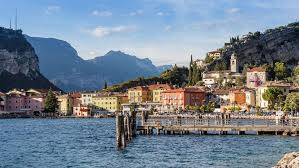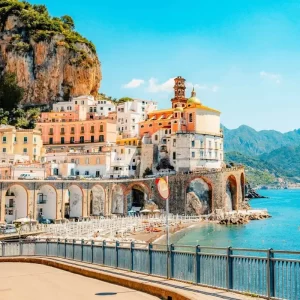Lake Garda in Italy sees summer tourism slump as German and Italian visitors decline

Rome: Lake Garda has always enticed travellers to its lovely towns, grand villas, and calm water activities. As Italy’s biggest lake, it usually fills up with visitors, especially German and Italian families, each summer. But summer 2025 feels unlike the rest. The hotels are less full, the booking apps show open rooms, and local shops are ringing up smaller totals at the cash register. Everybody is talking about the slowdown.
The sudden drop in visitors is worrying more than just the lake’s hotel owners and shopkeepers. It’s also got tourism boards and national officials worried because Lake Garda is a key part of Italy’s tourism income.
The hotel industry around Lake Garda has been particularly affected. Roughly one-fifth of rooms have been left unbooked, a figure that would normally be unthinkable during the peak of summer. Advance and last-minute bookings, which typically provide a steady flow of guests, have failed to materialise.
Shops, restaurants, and local service providers have also felt the impact. Turnover has been reported to have fallen between 10 and 20 per cent compared to last summer. The losses have been especially difficult for family-run establishments, which rely heavily on seasonal earnings.
Tourist behaviour has shifted in striking ways. German and Italian visitors, traditionally the backbone of Lake Garda’s summer season, have been noticeably absent. Their absence has been felt strongly since these two groups usually account for the majority of hotel bookings and restaurant spending.
While travellers from Northern Europe, particularly Scandinavia, have still been arriving, their patterns of travel differ. Many have chosen to stay in campsites instead of hotels. This choice has reduced their overall contribution to local businesses, as campsite visitors typically spend less in bars, shops, and other outlets.
One reason for the fall in German visitors has been attributed to road construction on the Brenner Highway, the vital route connecting southern Germany with northern Italy. Travel times from Bavaria, which normally average around five hours, have stretched to nearly seven hours this summer. The longer, more stressful journey has been enough to discourage many German families from making the trip, opting instead for closer or more accessible destinations.
Price increases have added another challenge. Across Italy, the costs of accommodation, food, and private beach services have risen. Fees for sun loungers and umbrellas on private beaches have reached levels that many visitors consider unaffordable. Data from industry reports shows that prices have increased by more than 17 per cent in just the past four years.
As a result, Italians themselves have been more cautious with their spending. Many have opted for mountain holidays or free public beaches instead of paying for exclusive coastal or lakeside services. The Italian Ministry of Tourism has acknowledged that consumer behaviour is shifting toward budget-friendly travel, with significant declines in visits to private beaches, where visitor numbers are estimated to be down between 15 and 25 per cent compared to the previous year.
The struggles at Lake Garda are not isolated. Across the country, tourism operators have reported similar concerns. From Ligurian resorts to Sicilian beaches, the pattern has been repeated: higher costs, fewer domestic visitors, and more cautious international spending.
Even in Mallorca, outside Italy, businesses have echoed similar concerns. Local shopkeepers have described a rise in so-called “diesel tourists” — visitors who walk extensively but consume very little. The trend points toward a broader European shift in summer travel behaviour, where value for money is being prioritised above tradition or prestige.
Efforts are being made to maintain accessibility and encourage tourism. Government-run ferry services such as Navigazione Laghi have continued to operate extensively on Lake Garda, carrying millions of passengers each year across Italy’s northern lakes. These services remain an important backbone for local mobility, ensuring that even when road access is limited, the lakeside towns remain connected.
At the policy level, the Ministry of Tourism oversees regulation, innovation funding, and national marketing campaigns to boost Italy’s image abroad. Lake Garda, being a flagship destination, is expected to benefit from future government initiatives aimed at supporting regional tourism in the face of economic pressures.
Academic studies and government strategies suggest that sustainability could become central to the future of destinations like Lake Garda. Research has shown that eco-certified or “green” destinations tend to attract a new segment of environmentally conscious tourists. If Lake Garda embraces stronger eco-tourism policies, there is potential to recover lost interest while differentiating itself from competitors.
With international travellers showing increasing preference for eco-friendly stays, local authorities and businesses may need to invest in certification, clean mobility solutions, and sustainable accommodations to remain competitive.
Lake Garda’s summer drop in visitors has set off alarm bells. Hotels report half-empty rooms, boutiques have fewer bags in hands, and groups that used to visit every year are skipping it. Turning the situation around won’t wait. Upgrading road and rail links, rethinking ticket and room prices to keep budgets in check while not cutting profits, and aiming campaigns at both Italian and overseas holidaymakerscan level off the rollercoaster and keep the lake thriving all year long.
Meanwhile, Lake Garda keeps its magic—from the mediaeval castles perched above Malcesine to the lively promenade of Sirmione, the water still sparkles with age-old beauty and deep culture. The real test ahead is to make sure the area stays welcoming and lovely for both long-time fans and new explorers, no matter how many seasons roll by.




